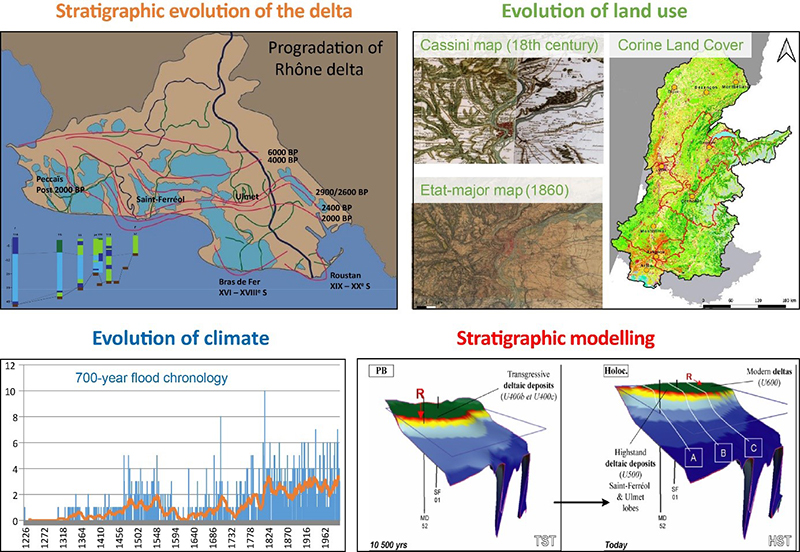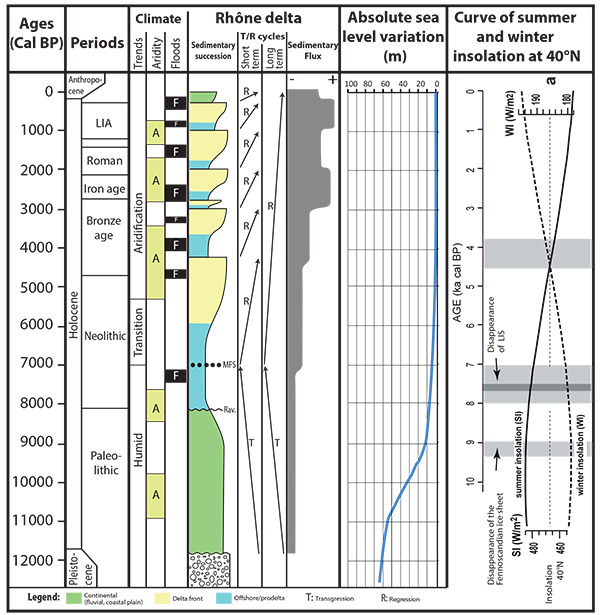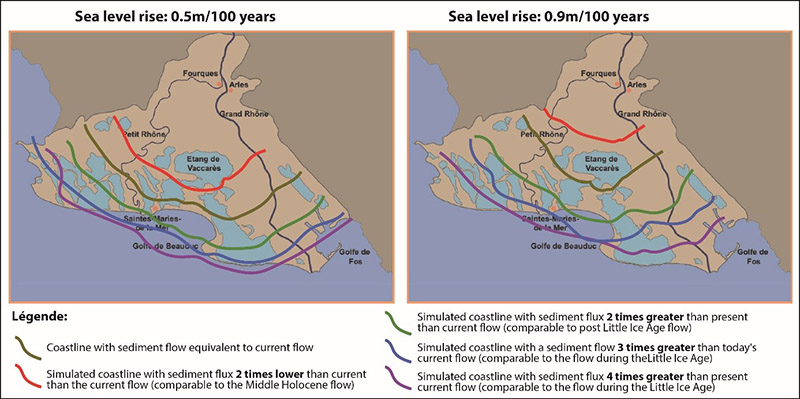Thesis by Théo Martinez: « Impact des paramètres hydroclimatiques et anthropiques sur la dynamique sédimentaire du système deltaïque du Rhône à la transition Holocène-Anthropocène » (Impact of hydroclimatic and anthropogenic parameters on sedimentary dynamics of the Rhône delta system at the Holocene-Anthropocene transition).
Coastal systems such as deltas are vulnerable to sea-level rise and erosion. The stability of deltas depends on the sedimentary input produced in the watershed, which is strongly impacted by climatic and anthropogenic factors, whose variations and increasing pressure lead to problems of resource management (aquifers) and land-use planning (bank instability, flood management, etc.).
In order to predict the impact of different environmental change scenarios and thus enable the implementation of appropriate local policies, it is essential to have modeling tools capable of integrating the various hydroclimatic and anthropogenic parameters and their temporal evolution. The development of numerical models capable of describing the factors modifying the natural environment is therefore necessary. Such models need to be parameterized, and the main challenge is to quantify the different forcing parameters1 and their consequences on the environment at different timescales.
The evolution of the Rhône delta since the last Quaternary glaciation is the ideal laboratory for studying human-environment interactions and their impact on the environment. The chronostratigraphic evolution2 of the Rhône delta and the river corridors of the upstream Rhône is well documented. Digital interpretation of old maps and satellite data has also enabled us to trace the evolution of land use over the last three centuries at watershed scale [1], which was then translated into erosion potential and flows of particles transported to the delta.
Using the stratigraphic model DionisosFlowTM software, these data were used to calibrate a stratigraphic model of the delta's past evolution and to reconstruct six main Holocene3 hydrosedimentary flow phases, with a marked threshold from 3000 cal. BP4 onwards.
On this basis, predictive scenarios for the evolution of the deltaic system were proposed (Figure 1) [2].

1- sedimentary analysis of the delta,
2- Estimation of volumes of sediments eroded in the catchment area from analysis of ancient maps,
3- Holocene climate evolution, in order to
4- calibrate a stratigraphic modeling approach.

over Holocene period in relation to changes in sea level and climatic.
The volume of sediments associated with the different phases of the Rhône delta construction over the last 11,700 years were calculated through a high-resolution stratigraphic study:
- It took more than 4,000 years for the Rhône delta to start to develop around the year 7,000 cal. BP. The estimated sedimentary volumes from the mid-Holocene period to the late Holocene period are associated with hydroclimatic events.
- Changes in sedimentation rates, associated with periods of climatic and anthropogenic forcing phenomena, are identified around 3,000 cal. BP.
These changes appear to represent a major bifurcation with more extensive and intensive human forcing from this period (Figure 2) [2].
The results of prospective simulations indicate that in the absence of an increase in sedimentary flow, the delta coastline could retreat by several kilometers by the year 3,000, with a 60% reduction in its surface area (Figure 3). To compensate for a 50 cm/century rise in sea level (optimistic scenario), sedimentary flow would have to be three times greater than the present-day flow, and five times greater for a 90 cm/century rise (pessimistic scenario).

by modeling two rising sea level scenarios:
0.5 m/100 years (optimistic IPCC scenario)
and 0.9 m/100 years (pessimistic IPCC scenario).
On the basis of quantitative data relating to hydrosedimentary flows reproduced for the past 12,000 years, this research provides an insight into the future evolution of a delta system such as the Rhône. Thus, in addition to the methodology developped in this thesis work, it illustrates the ability of numerical simulations to produce predictive scenarios of coastal evolution associated with anthropogenic or climatic activity.
1- i.e., the external constraints applied to a system in equilibrium.
2- Relative to the organization and division of rock strata as a function of their age relationships.
3- Geological period extending over the last 12,000 years.
4- Calendar years before the present.
References:
-
T. Martinez, A. Hammoumi, G. Ducret, M. Moreaud, R. Deschamps, H. Piegay, J-F. Berger, Deep learning ancient map segmentation to assess historical landscape changes, 2023, Journal of Maps, 19:1.
>> https://doi.org/10.1080/17445647.2023.2225071
-
Martinez, T., Deschamps, R., Amorosi, A., Jouet, G., Vella, C., Ducret, G., Berger, J.F., Holocene stratigraphic architecture of a Mediterranean delta and implication for sediment budget evolution: Example of the Rhône delta, 2024, Sedimentary Geology.
>> https://doi.org/10.1016/j.sedgeo.2023.106574
Scientific contact: remy.deschamps@ifpen.fr






